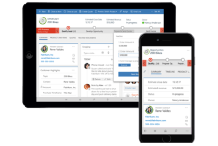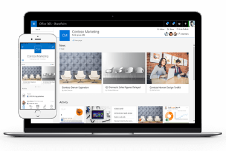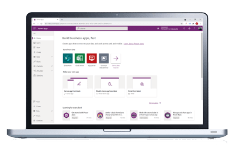Table of contents
- What is Power Automate?
- Adding Power Automate to Team
- Template Categories in Teams
- Scheduling a meeting with a message sender
- Initiating a Scheduled Meeting Flow
- Following Up on a Message
- Social Media Templates in Teams
- Automating Approvals
- Reviewing and Editing Flows with Power Automate
- Creating a Flow from Scratch
- Conclusion
- Related
Chances are, you know that Microsoft Teams is a solution that delivers big in terms of collaboration, allowing your organization to share essential project files, meet, and communicate with ease. What you may not realize is how you can automate much of the functionality within Microsoft Teams using Power Automate, streamlining your team’s repetitive tasks and enhancing efficiency and productivity.
Microsoft Teams provides video calling, video chat, and group chat to video capabilities, making remote working a more streamlined and fluent experience. Teams integrates seamlessly with your existing Microsoft Office 365 calendar. This therefore means you can schedule events such as video calling or chat right from your calendar. Join meetings direct via a link or calendar invite for fast access.
What is Power Automate?
Previously known as Microsoft Flow, Microsoft Power Automate works with Teams via a connector— a proxy or a wrapper around the API that allows the underlying service to talk to Microsoft Power Automate and then provide users with a way to leverage prebuilt triggers or actions in building their workflows. While there are different ways to create flows from with Power Automate itself, in this article we will walk through the simplified interface created in Teams for users who want to leverage Power Automate.
Power Automate is used with various programs to create automated workflows, automatic processes, automate tasks, and much more. When it comes to automated processes, Power Automate also works very well in Dynamics 365. Imagine a process that is used in Project Power Apps to turn a project requests into a project. Automate repetitive tasks is a way to streamline processes while reducing human error.
Adding Power Automate to Team
To begin, you will need to make sure you have Power Automate added into Teams. To do this, sign into your Teams account and click on the Apps icon, which you will find at the bottom of your left-hand navigation bar. Run a search for Power Automate, select it and click ‘Add’ to make sure it’s connected to Teams. Once the Power Automate icon appears, right click on it and select pin to make sure that you can find it quickly and easily when needed.
Once Power Automate is paired with Teams, clicking on the power Automate icon pulls up a list of common Power Automate Templates used in Teams. You will also see a search bar that you can use to search for a particular template. The Power Automate tab automatically defaults to Teams-specific templates in Teams, but you can toggle the list next to the search window to view all templates, if you like.
Template Categories in Teams
When you click on the ‘Create’ tab in the Power Automate app in Teams, this pulls up a list of the most popular categories of templates used for Teams. These include:
- Approval
- Button
- Calendar
- Data collection
- Mobile
- Productivity
- Remote work
- Social media
- Sync
- Notifications
Within each of these categories, there are a wide range of templates that you can take advantage of. Below, we will walk through some of the most popular ones in a variety of categories.
Scheduling a meeting with a message sender
One of the most popular templates in the Calendar category is one that allows you to schedule automatically a message from a sender inside any Teams chat or channel. Imagine this scenario: You receive a message from a co-worker in Teams requesting a meeting. Historically, you would need to move over to Outlook to schedule the meeting. With the automation feature powered by Power Automate in Teams, you can now do this directly in your conversation with that individual in a Teams chat or channel.
Under ‘Create’, click on the Calendar icon, which should pull up the template titled “Schedule a meeting with a message sender.” Clicking on the template pulls up a pop-up window where you can create the flow. If you need to, sign into Microsoft Teams on the first screen, then click on Continue. On the next page, select the calendar you want to use to schedule your meeting, as well as the time zone in which you want to schedule that message.
You can also drill in on more detail by clicking on the ‘Edit in advanced mode’ option at the bottom left of the pop-up window. To complete the flow, click on ‘Create Flow.’
Initiating a Scheduled Meeting Flow
Once you have created the flow for automatically scheduling a meeting with a message sender, you will be able to access a shortcut button to schedule a meeting right in your chat or channel with the message sender.
Go to the message from the sender with whom you want to schedule a meeting. Hover your mouse over the message, then click on the ‘…’ icon, scroll down to ‘More Actions’, then select ‘See More.’ From there, you can click on Schedule a Meeting.
This pulls up a dialogue box where you can set up the meeting. This meeting is then automatically plugged into your calendar.
Following Up on a Message
How many times have you forgotten to follow up on a message during a busy work week? Probably more often than you’d like to admit. Another popular tool for automation with Power Automate reminds you to follow up on messages.
You can find the template under Productivity in the Power Automate templates or run a search for ‘follow up on a message.” Creating the flow is a simple process of clicking on the template and then clicking on ‘Create Flow.’
Once you are in a message that you want to follow up on, click on the three-dot icon, scroll down to ‘More Actions’, then select ‘See More.’ You will now see an automatic button there called ‘follow up on message.’ This pulls up a pop-up on which you can select a time range for when you want to follow up. These options are:
- 20 minutes
- 1 hour
- 3 hours
- tomorrow
- In a week
Select the time increment that works for you. When the time comes for you to follow up, you will receive a message in Teams alerting you to take action on the original message.
Social Media Templates in Teams
A significant part of project management today involves careful monitoring of all social media activities. Power Automate in Teams provides an easy way to do this, alerting you automatically to specific social media actions. Popular social media Teams templates available in Power Automate include:
- When an RSS feed is published
- When a new message is posted to a followed feed
- When a new message is posted in a Yammer group
- When a tweet with a hashtag is posted
Instead of spending time checking in on your social feeds, Power Automate will automatically alert you to any activity.
Automating Approvals
One thing that really drags down efficiency on a project team is approvals. They can wait in inboxes for days or go unnoticed, slowing down workflows unnecessarily. Power Automate allows you to create a number of approval flows based on different tasks.
Select ‘Create’ in the Power Automate toolbar, then select ‘Approvals’ to pull up a list of available templates for approval flows. You can run a search with a keyword search term to find the right template for your needs. Microsoft offers a template for almost anything, from an approval initiated by a form submission to an approval initiated by the creation of a OneDrive file.
Reviewing and Editing Flows with Power Automate
You can easily review and edit all flows that you create in the Home tab of Power Automate in Teams. Clicking on the Home tab takes you to a complete list of all your Teams flows created by Power Automate. Clicking on the three-dot icon on the right end of a list item, pulls up a list of actions you can take on that flow:
- Edit
- Share
- Run History
- Delete
Editing a flow from this entry point allows you to drill into more detail on that flow, if necessary. In edit mode, you can:
- change the form id
- add a new step
- add a parallel branch
Parallel branches are particularly useful when you need to create different actions, for example, if a response involves an approval or a rejection.
Creating a Flow from Scratch
Once you become more experienced using Power Automate in the context of Teams or if you can’t find a template to fit your needs, you can also create a new template from scratch. To do this, go to the Create tab in Power Automate in Teams and click on ‘Create from Blank.’ This pulls up a creation form that you can use to design your own flow template.
At the top you will see a list of all the apps that can trigger a flow in Microsoft Teams. Below that, you will see two tabs containing all the triggers and actions that can structure a flow. Clicking on a particular app automatically pulls up the most common triggers and actions associated with that app. For example, if you selected Google Calendar, a popular trigger that might come up would be related to when an event is added to the calendar.
Conclusion
Integrating Power Automate into Teams is essential. With this added functionality, you will be able to automate daily tasks and streamline workflows so that you and your team are working more efficiently. To learn more about Power Automate and Teams or explore how Teams and other Microsoft solutions can enhance performance and collaboration at your organization, visit integent.com today.















